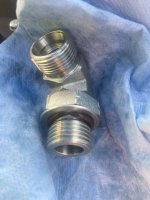OP
zwelch
Member
- Joined
- Apr 16, 2022
- Messages
- 38
- Location
- Summit, Oregon
- Tractor
- Kubota L4200, Sany SY35U, Komatsu D20P-6
Travel speed is definitely slow, but the swivel/arm controls are fairly responsive. With a full bucket at full extension, the arm will have enough weight that rotating too fast will easily lead to tipping over the machine. That's true even with my bigger machine, and the same kind of thing happens with a fully raised front-end loader on a tractor. If you go slow, you can feel one side of the machine start to lift off the ground, and you can take action before things go sideways. Move too fast, and you're not going to be able to react in time....Nice analogy but not sure these things get too much speed.
Personally, I felt that the auction prices for the larger machines like the VC15 were disproportionately higher for a relatively marginal increase in power/size.I only need a small machine. There is also the VC-15 that's available near me, which is a little larger but I don't think by much. It has the pilot controls but from what I've seen they are not the real deal pilot controls.

